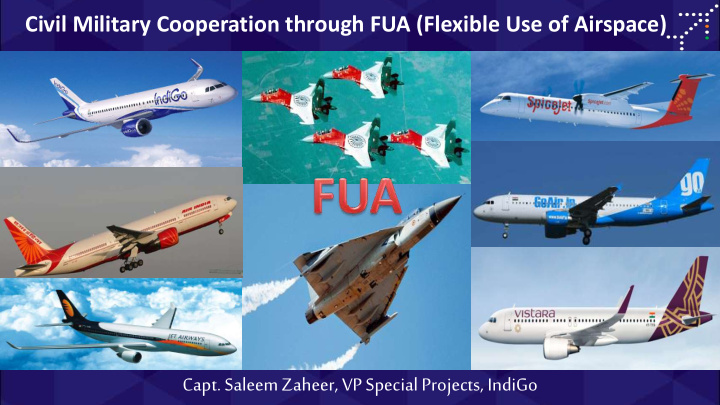



Civil Military Cooperation through FUA (Flexible Use of Airspace) Capt. Saleem Zaheer, VP Special Projects, IndiGo
Why is airspace sharing necessary? • Over 300 million and growing middle class driving consumption and fueling growth • India is expected to become the 5th largest consumer economy by 2025 from the 12th largest in 2007 • 600 million people expected to be in upper and middle income bracket by 2025 Source: McKinsey
Rail to Air Substitution Supportive of Demand 2015 Passengers 8,400 81 million million < 1% of rail passengers Increasing Changing Large Market Disposable Consumer Potential Income Preference Substitution from rail to air
IATA Forecast: 2016-2034 • The five fastest-increasing markets in terms of additional passengers per year over the forecast period (2016-2034) will be: • China (758 million new passengers for a total of 1.2B passengers ) • US (523 million new passengers for a total of 1.16B billion) • India (275 million new passengers for a total of 378 million) • Indonesia (132 million new passengers for a total of 219 million) • Brazil (104 million new passengers for a total of 202 million) • India will displace the UK as the third-largest market world-wide in 2026
Other Forecasts • DGCA India, 2016: Monthly DGCA reports show Indian passenger numbers growing 20 – 25% YOY • CAPA forecasts YOY growth from 81 million pax in FY 16 to 100 million in FY 17 (23% growth) • Boeing Current Market Outlook, October 2015: India will need 1740 new airliners by 2034 • Airbus: India will need 1300 new airliners by 2032
CAPA – AIRLINE A/C ADDITIONS 2015-2025
A Reasonable Prediction • It would be fair to say that there will be 600 airliners operating in India by December 2018, 30 months from today • A 50% increase from today’s 440 airliners • All using the same finite, limited Indian airspace Effectively managing these numbers in the service of the travelling public is our challenge
Air Traffic Management: An Environmental Solution for Aviation • Air Traffic Management (ATM) improvements represent the greatest near-term environmental opportunities for significant reductions in aviation fuel burn and CO2 emissions By using more fuel efficient routes By more effectively sharing airspace between military and civil users Cutting flight times by one minute per flight on a global basis would save 4.8 million tons of CO2 every year (IATA)
Formation of NHLAPB & NAMAC October 2013 : - Formation of National High Level Airspace Policy Body (NHLAPB) for airspace - Chaired by Secretary, Ministry of Civil Aviation - With representation from Ministry of Defence, Indian Air Force, Indian Navy, Indian Space Research Organization, Airports Authority of India and Directorate General of Civil Aviation - National Airspace Management & Advisory Committee (NAMAC) in early 2014 - Includes Airline Members
Flexible Use of Airspace 1. The FUA Concept provides the Air Traffic Management (ATM) system with the potential to increase capacity 2. FUA came into existence to manage increasing traffic flow – both civil and military 3. The FUA Concept allows the maximum shared use of airspace through enhanced civil/military co-ordination 4. Concept strives for airspace segregation that is temporary and based on real use for a specified time period
Benefits Reaped Due To Implementation of FUA
Conditional Route J1-CDR 2 Kolkata - Jaipur Period Fuel Savings Cost Savings Reduced CO2 (KG) (INR)/USD Emission (Ton) NOV 2014 to MAR 748000 4.75 Cr/ 2400 2016 0.7 Million
Conditional Route J2-CDR 2 Nagpur -Pune Period Fuel Savings (Kgs) Cost Savings Reduced CO2 (INR)/(USD) Emission (Ton) SEP 2015 to MAR 2016 67000 40 lac/59000 212
Conditional Route J4-CDR2 Kolkata-Hyderabad Period Fuel Savings Cost Savings Reduced Co2 (Kgs) (INR)/(USD) Emission (Ton) JUN 2015 to MAR 2016 57000 38 lac/57000 179
Q16 & Q17 Route Overflying OZAR Airspace Conditional Route Period Fuel Savings Cost Savings Reduced CO2 (Kgs) (INR)/(USD) Emission (Ton) MAR 2015 to MAR 3,70,000 2.4Cr/0.3 1147 2016 Million
Conditional Route J8-CDR2 Dimapur - Kumbhigram Period - Fuel Savings Cost Savings Reduced CO2 Only Sundays (Kgs) (INR)/USD Emission (Ton) OCT 2015 to MAR 8000 5.7lacs/8500 28 2016
CO2 Reduction and Fuel Savings (The MAGIC of saving 100Kg per flight) APR 2016 No. of Flights/Year Fuel Saving /Year/ Fuel Savings /Year CO2 Reduction/Year (Tons) (INR)/USD (Tons) 245,000 24,500 116 Cr/17.4 Million 77,200 APR 2015 No. of Flights/Year Fuel Saving /Year/ Fuel Savings /Year CO2 Reduction/Year (Tons) (Rs) (Tons) 210,000 21,000 155 Cr/23.2 Million 66,200
What more can be done with Civil Military Cooperation?
Direct Route Between PK and CHG There is only one route to fly to/from Jammu and Srinagar. In case connectivity between PK and CHG is made available and the traffic is bifurcated from DPN so that inbound traffic to Jammu and Srinagar follows DPN-PK-SNG and Outbound traffic follows SNG-PK-CHG-DPN This will not only ease the traffic density but also help all Airlines in getting optimum level hence less fuel burn and less CO2 emissions.
Approach Corridor Through Hindon Airspace
Proposal for BPL-AAE-RASKI
Predicted Fuel Saving/Year=4,51,400 No. of Flights per month 570 Kgs 11 NM Reduced CO2 Emissions= Saving Per Flight Distance 1425 Ton
Controllers FAM Flights 1. Every year airlines as a best practice take civil controllers for familiarization flights to different airports 2. 80 controllers were approved in 2015 3. 100 controllers on domestic flights and 20 for international flights have been approved in 2016 4. We would be extremely pleased to welcome Air Force/Navy controllers in our cockpits
Thank You Any Questions
Recommend
More recommend